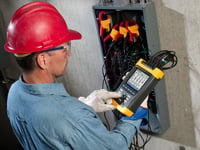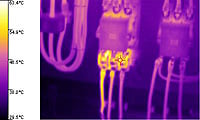
For the most part industrial and commercial electrical systems are getting safer and more reliable. The U.S. Fire Administration's most recent report, analyzing data from 2001, estimates that 8.7% of the nation's 47,785 non-residential fires were caused by electrical distribution equipment. That's 32% fewer than in 1998.
Strict building codes, high-quality equipment, good system design, competent installation and professional maintenance are all factors in driving the downward trend. Still, this translates to 4,157 commercial, industrial and institutional buildings struck by electrical fires in 2001.
Commercial, low-voltage systems contain many sub-systems: switchgear, transformers, panels, receptacles, motor controls and lighting, to name a few. Common to all of these components are connections, insulation and overcurrent protection. Failures of these fundamental mechanisms are at the root of many electrical fires and are the target of many electrical maintenance procedures.
NETA Maintenance Testing Specifications and NFPA standard 70B Recommended Practice for Electrical Equipment Maintenance list procedures for testing the various components of an electrical distribution system. Thermographic testing is covered by ASTM E 1934 Standard Guide for Examining Electrical and Mechanical Equipment with Infrared Thermography.
Many of the tests aimed at preventing electrical fires also address reliability and safety, so a good testing program can deliver all three. In fact, many industrial insurance companies require evidence of a regular electrical testing program.
This article reviews the fundamental causes of overheating, as well as, the tests and tools commonly used to uncover overheating problems.
Use thermal imagers to check energized components for hot, loose or corroded connections. Thermal image of a loose terminal contact.
Root causes of overheating in electrical systems
Combustion requires both heat and fuel. Designers of electrical equipment are careful to use fire-resistant materials, making the electrical system a poor provider of fuel. The fuel for the fire usually comes from some nearby material, with the electrical system providing the heat required for ignition.

Heat is a normal byproduct of the flow of electric current. The National Electrical Code takes heat into account and provides rules for building a safe electrical system. So how can an electrical system that was designed and built to comply with the NEC still cause a fire?
Poor connections. Vibration or thermal stress can cause connections in power distribution systems to loosen. Contamination can corrode connections. Both factors increase the resistance of the connection. All terminals and splices are potential candidates for overheating, although the more current a connection carries, the more critical it is to maintain low resistance. Consider that if a connector in a 50 amp system presents just 0.1 Ohms of resistance, it will dissipate 250 watts at the interface of the connection! Furthermore, if the condition is allowed to persist, oxides will build up on the connection interface, causing the resistance to increase. Ultimately this can result in what is called a "glowing connection", which can generate significant heat without tripping protection devices.
Loose connections that periodically "make and break" can also cause series arcs. Arcs are electrical discharges across an air gap. In this case the arc is generated across the small gap between conductors as the connection opens repeatedly. The resulting heat is very focused and may lead to insulation failure or fire if a combustible fuel source is nearby. Switches, relays and circuit breakers are also forms of connection. They are designed to open and close repeatedly without overheating, but they are subject to the influence of vibration, heat, and contamination just as any other connection.
Insulation failure. One of the reasons that electrical fires are less common is that the quality of insulation is better than in the past. But any insulation system will still degrade with age, heat and contamination.
The most extreme form of insulation failure is a short circuit. In this case, two conductors make contact and remain in contact. The resulting overcurrent should cause a fuse or circuit breaker to open. But if the overcurrent protection device fails to open, the circuit upstream of the short circuit will be subject to overheating.
If there's a ground fault (a short circuit involving an equipment ground), then the breaker should also open. If it doesn't, the same overheating arises. If there's a resistive connection in the bonding system that limits the current, the resulting current may not be sufficient to trip the upstream protection devices but may still cause heating in the bonding system.
Parallel arcing occurs when two connectors come close, or touch and part. It has similar characteristics to series arcing (above) but tends to involve higher currents. This can cause ignition of a nearby fuel source or further degradation of the insulation. Arcing can discharge hot metal sparks that can ignite a nearby fuel source.
If insulation is subjected to the heat of other failures, the surface of the insulation can char and become conductive. A phenomenon called arc tracking can result, causing intense localized heating similar to other arcing.
Lightning. One of the functions of the ground system is to provide a low impedance path to earth, allowing a lightning strike to pass with as little damage as possible. Surge suppressors rely on a good ground path to operate effectively. Periodic testing of the ground system and the resistance between the ground electrode and earth helps to insure that this system will work when it needs to.
Harmonics. Most of the current that flows in a US electrical system cycles at 60 Hz. Harmonic currents contain higher frequency components that generate heat throughout the system. Harmonic distortion is present in any electrical system that supplies electronic loads like motor drives, computers, control systems or production machines. Extreme distortion and heavy loading can cause overheating in electrical equipment, especially in older distribution systems.
The third harmonic is caused by single-phase loads like computers and other office machines. This harmonic adds in the neutral in a 3-phase system and can cause the neutral conductor to overheat if it is too small.

Avoid electrical shorts by testing the insulation resistance on cabling. Periodically examine power quality for voltage sags, harmonics and other causes of overheating.
Overloading. If a load draws too much current, the system components upstream of the load have to carry that current. The main protection against overload is the overcurrent protection device which should open. If it does not open, the high current will cause overheating distributed along the portion of the system upstream of the excessive load.
Wiring mistakes. The electrical system in commercial buildings is a dynamic entity. Over time, tenants change, production lines move, and new equipment gets installed. In a time crunch, mistakes are common and although a system may operate just fine for a while, latent problems can be created.
A potential fire hazard exists when someone "upsizes" a protection device without changing the wire size. For example, simply replacing a 20 amp circuit breaker with a 30 amp circuit breaker could allow existing 12 AWG wiring to carry excessive current. A similar situation occurs any time someone connects a smaller gauge wire to a circuit with higher ampacity.
Using one neutral conductor as a return path for more than one phase conductor will enable loads to function but can easily overheat the "shared" neutral conductor.
Tests and measurements for detecting heat and failing components
The trick with detecting electrical fire hazards is knowing what an abnormal reading looks like. The best solution is to gather baseline readings for especially important components and equipment. That gives you a point of comparison. Then, make a habit of performing these tests once a year. That will spot other kinds of failures in the works, as well, yielding predictive maintenance cost savings as well as fire prevention.
Here are the most common tools and measurements that testing professionals use to check for overheating or an inclination towards overheating.
Visual inspection. Electricity may be invisible, but the effects of heating on metal and insulators are not. Discoloration or charring is a sure sign that components are overheating. Also be alert for smells, like an overheating component would produce.
Thermography. Thermal imagers can read the infrared energy emitted by an object and create a visible image of the object's surface temperature. Hot, loose connectors show up dramatically on these thermal pictures, especially in comparison to cooler, tight connections. This non-contact technique is perfect for checking energized components and scanning operational equipment, but it can't measure concealed (thermally-insulated) insulation or connections. Likewise, electrical panels must be open for the imager to measure the components. Follow NFPA 70E safety procedures and wear appropriate personal protective equipment (PPE) in these instances.
Connection/switch resistance. Another method for checking connectors is by electrically measuring the resistance of the connection. On an energized system, a resistive connection will cause a measurable voltage drop across the connection. A precise, properly-rated handheld voltmeter will do the job. However, this test does involve probing an energized system, so safety is a concern. The technician must closely follow PPE requirements and OSHA protocols.
On a de-energized system, using a micro-ohmmeter will produce much more accurate results. This tool applies a dc current of 10 amps or more through a connector and precisely measures the voltage drop. This test shows the resistance of a connection down to a fraction of a micro-ohm, insuring that the connection will not dissipate excessive heat - or, identifying connectors that could be hazardous.
Insulation testing. Insulation resistance is measured between phase conductors and between phase conductors and ground conductors. Good insulation should have very high resistance. An insulation tester applies a high dc voltage to de-energized, isolated components. The instrument then measures the resistance between the two points. This testing can be used to check large segments of insulation, including long lengths of cable, transformer windings, and motor windings. Low insulation resistance readings can indicate that somewhere on that length the cable is breaking down, potentially causing a short.
Ground resistance testing. Periodic ground measurements can help make sure lightning damage is minimized in the event of a strike. Obviously the need is more urgent if you are responsible for facilities in lightning- prone areas. A ground resistance test is usually performed during a system shutdown, because the ground electrode must be disconnected temporarily.
Transformer turns ratio. Insulation failure inside transformers can result in shorted turns, effectively reducing the number of turns on the effected side. A transformer with shorted turns is prone to overheating. You can check the ratio on a low voltage transformer by isolating the secondary from loads and using a voltmeter to compare the primary voltage to the secondary voltage. A more accurate approach is to use a special transformer-winding test set, which will give a precise ratio as well as a good picture of the magnetic characteristics.
Circuit Breaker Testing. Circuit breakers are the key to electrical fire prevention. Proper testing of circuit breakers requires special equipment and specialized expertise. Testing is performed with the breaker removed from the circuit and the tests verify the trip current and delay.
Power Quality Measurements. Power quality studies can uncover symptoms that signal potential overheating. Periodically measuring harmonic distortion will alert you to potential heating problems due to excessive harmonic current. Voltage sags can be viewed as annoyance, but in systems serving a consistent load they may be caused by deteriorating connections. Many wiring problems become apparent during a comprehensive power quality study.